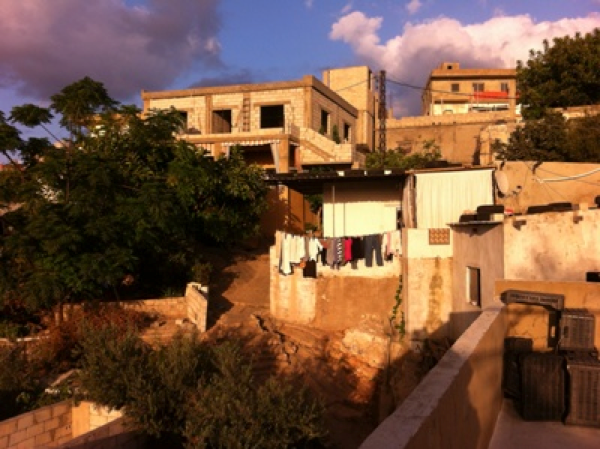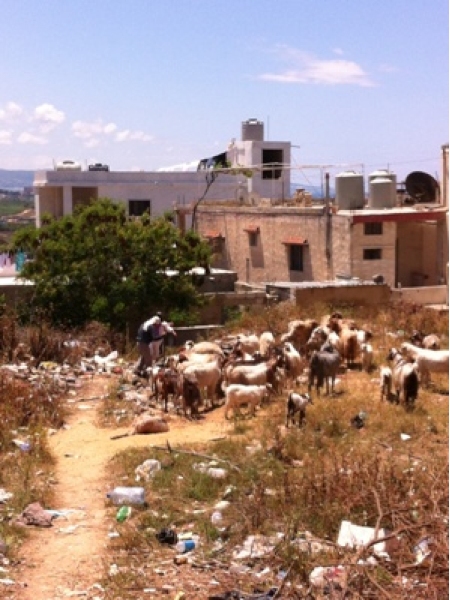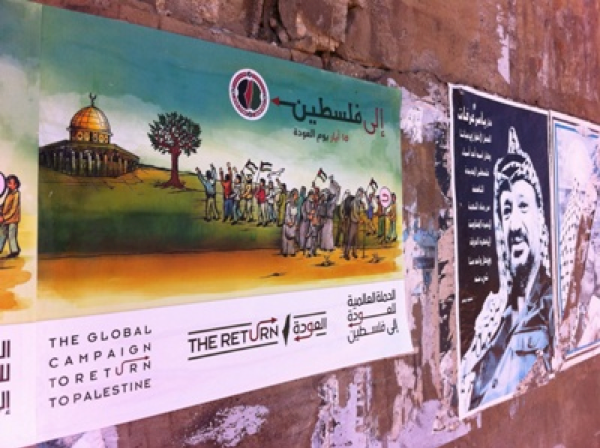Lebanon’s Palestinian refugee camps and the plight of their inhabitants are well-known. The twelve Palestinian camps in Lebanon are often described as either spatially segregated “states-within-the-state” or as socio-economic “islands of marginalization” (Czajka 2012). The majority of Palestinians in Lebanon, however, do not live in these (in)famous camps. Instead, they live in so-called “adjacent areas” (AAs), which are illegal extensions of the camps, or in “gatherings,” which I define as small, unofficial camps that are not located, as AAs are, in the immediate vicinity of the official camps. These gatherings are neither administered by the United Nations Relief and Works Agency for Palestine Refugees in the Near East (UNRWA) nor recognized by the Lebanese state.
My research focuses on governance dynamics in several such gatherings in South Lebanon. In this essay, which draws on my fieldwork weblog—especially the entries "Migration: Money over Morals?” and “Life and Law in Limbo”—I demonstrate how the categorization of gatherings is dominated by informality and institutional ambiguity. Then, by looking at two cases that I encountered in Shabriha gathering, a Palestinian “camp” located next to the Lebanese village of Shabriha, just off the coastal road entering Tyre/Sour from the North, I illustrate how this categorization has very real effects on social justice. More specifically, I explore the ways in which the forms of displacement featured in these two cases–imposed eviction and desired migration—are shaped by the institutional vacuum that characterizes the gatherings.

[Late afternoon in Shabriha. Image taken by author, spring 2013.]
Between Camp and Municipality: The Institutional Ambiguity Characterizing Palestinian Gatherings
In addition to the three official Palestinian camps in the Sour region, there are eleven unofficial camps, varying in size and location. Unlike the camps, these coastline gatherings do not fall under the administrative and humanitarian mandate of UNRWA and they are not located on land rented by UNRWA from the Lebanese state. While many of the inhabitants of the gatherings use UNRWA clinics and schools, UNRWA does not provide water, electricity, waste management or infrastructural services in the gatherings. The Lebanese state and its municipalities do not recognize the gatherings as Palestinian camps, but also mostly do not approach the gatherings’ residents as part of their population or service constituency. In some cases, de facto service delivery arrangements have emerged over the years, with people from the gatherings paying small fees and receiving some services to complement those of UNRWA. Yet, these informal and often unstable arrangements are overwhelmingly dependent on the personal goodwill of particular local authorities. In many other gatherings, including Shabriha, such service arrangements have not materialized at all—even if residents are willing to pay fees—because relations between gatherings and municipalities are marred by conflicts as a result of the Palestinians’ illegal inhabitation of public land.
The coastline gatherings were created slightly later than the official camps, mostly in the early 1950s. They host predominantly Palestinian people and by and large do not encompass the wide variety of nationalities that characterizes the camps, especially those in Beirut. Lebanon’s violent history has direly affected the gatherings, as evidenced by, for instance, their reception of many of the residents of the Tall Al-Zaatar and Nabatiyeh camps after these camps were destroyed, and by the almost complete displacement of Shabriha throughout episodes of the Lebanese Civil War. While the post-war period has brought positive developments to the gatherings, as it did to all of Lebanon, the reinstatement of the municipalities has not been unequivocally positive for the gatherings’ residents, who increasingly face land claims by both public authorities and private owners.
The institutional context of these gatherings, then, is related to their spatial distance from the camps and thereby differs from the setting in AAs. This context is characterized by two core notions. On one hand, informality as manifested in legal marginalization: Palestinians living in Lebanon do not have Lebanese citizenship and, as a result of a March 2001 law, cannot own land or real estate. For Palestinians living in the camps, this inability to obtain land titles is partially covered, however inadequately, by their inclusion in the UNRWA mandate, but this is not the case for Palestinians living in the gatherings. On the other hand, the institutional context in the gatherings is typified by a vacuum of service delivery and representation, manifested in the absence of both the Lebanese state and UNRWA. The NGO PARD, one of the few working in the gatherings, noted in its annual report for 2011 that “tens of thousands of Palestinian refugees in Lebanon who live in unofficial ‘gatherings,’ collections of homes built without official permission, are left unattended by UNRWA, the Lebanese state, or the Palestinian Authority.” This reality was constantly reiterated by the people I interviewed. A Palestinian NGO representative explained that “the gatherings don’t fall under UNRWA responsibility [considering service provision]; UNRWA says it is the responsibility of the municipality. But the municipality says ‘go to UNRWA.’” A state official in Sour confirmed this, saying “we have an official agreement with UNRWA concerning the recognized camps, we deal officially with them. But we don’t care about the unofficial camps, they aren’t part of the official agreement.”
The unofficial status of the gatherings thus results in an institutional vacuum that makes the gatherings less attractive as a constituency for both NGOs, few of which work in the gatherings, and Palestinian parties, who notoriously under-prioritize their distribution and representation in the gatherings. An NGO representative in Sour noted that “many people prefer to call gatherings camps because this makes them sound more important. ‘Gathering’ has associations of randomness, ‘a group of people gathered together,’ whereas the word ‘camp’ signifies joint relations. His colleagues added: “This really is the problem, there is a lack of institutions in the gatherings. There are no centers for women or for the kids […] These institutions are only in the camps. This might be because the camps are the symbol of refugees and the focus of Palestinian suffering.”
Many of the coastline gatherings in the Sour area are inhabited by Palestinians with a Bedouin background. In my interviews with residents from Shabriha, some people told me that their (grand)parents, after the 1948 Nakba, consciously chose not to settle in the official camps, allegedly because they were afraid their extended family clans would be separated by UNRWA distribution regulations and they would be forced to give up their cattle. Notwithstanding this initial deliberate choice, they now struggle to deal with the hybrid situation in which they find themselves. Such hybridity manifests itself in nothing so much as in uncertainty: uncertainty about who to turn to for services, about the consequences of illegally living on public land, and about which security regime they fall under. In the words of one youth group leader: “The situation here is totally clouded and unclear, and it is meant to be cloudy, we are meant to not be able to understand it.”
Eviction from Informality
Two phenomena that I encountered during my fieldwork show the very real repercussions of this “cloudedness” that follows from the illegality and institutional ambiguity, which are in turn consequences of the gatherings’ spatial distancing from the camps. The first case is constituted by the responses to a looming eviction of part of Shabriha that would be the result of the construction of a national highway. The highway is being built on public land, owned by the state and hence for the state to use as it sees fit. The people who live on this land do so illegally and without paying taxes. For fifteen years, they have been warned about the construction of the highway and their upcoming eviction. Despite their status as squatters, there is a widespread hope, shared among state representatives, that evicted households will receive compensation. At first sight, then, the eviction of some forty households from Shabriha seems an unfortunate, but justified procedure.
But in Lebanon things are always messier than they appear. There is, first of all, the general marginalization of the Palestinians that complicates eviction and compensation procedures. The legal status of Palestinians in Lebanon is one of systematic discrimination. As stated above, Palestinians are not allowed to own and register real estate. Whereas some people suggest they could simply rent an apartment, their exclusion from some seventy job categories makes it extremely difficult for them to earn enough money to make a living, let alone to afford Lebanon’s relatively high rents. On top of this, official Palestinian camps have, since their installation in 1948, become notoriously overcrowded due to natural population increase and an influx of migrant workers and cannot absorb more people. They have not been expanded since their initiation and now host a population five times larger than they were designed to accommodate. The camps’ population density has become even more pressing now that Lebanon faces a dire refugee crisis as a result of the war in Syria. Moreover, besides this general marginalization, the fact that the Palestinians are from a gathering, rather than a camp, decisively influences both the cause and the effects of a possible eviction. In terms of cause, the very emergence of the eviction threat is related to the land ownership situation particular to the gatherings. The Lebanese state would almost certainly not have been able—or arguably willing—to construct a highway through a Palestinian camp, but it does not mind doing so through a gathering. In terms of consequences, Palestinians from Shabriha complain about a protection vacuum. Lebanese organizations are pointing out the Palestinian residents that will be evicted and Palestinian organizations are referring to the Lebanese land ownership situation that should be taken into account. Ultimately, neither of them effectively protects the interests of the residents in terms of, for instance, a deviation of the highway or the residents’ relocation and/or compensation.
In the highway project, the Lebanese government is represented by the Council of Development and Reconstruction, which is specifically tasked with all infrastructural development programs in Lebanon. This council has granted the project to a consultancy firm which in turn has hired a local contractor to do the construction work. In addition, the state is represented by a legal commission that has informed affected land owners of their pending eviction. But since the Palestinians living in Shabriha are recognized by the state as neither citizens nor landowners they have no legal position in the process and their experience throughout the project’s history is one of chronic uncertainty and insecurity. They have received only piecemeal information—a court order here, some informal advice from engineers coming to document their presence there, and occasionally some news from a municipal employee they befriended. None of the organizations or institutions involved in the process have been given (or have taken) the responsibility to structurally communicate with these people about their future. This problem is exacerbated by the lack of a Palestinian representative body recognized by the Lebanese authorities as well as the absence of the socio-political clout represented by Palestinian institutions in the camps, making people’s relations with the various institutions in the highway project fragmented and haphazard. The situation described above is of course not entirely unique: Lebanese people living in informal settlements face similar challenges (Deboulet and Fawaz 2011), as evidenced by the Lebanese residents who are also threatened with eviction. However, the illegal settlement status of the gatherings as a location combined with the legal marginalization of Palestinians as a community leave the residents with few resources to withstand their eviction.

[A shepherd in upper Shabriha. Image taken by author, spring 2013.]
Migration from an Institutional Vacuum
A second phenomenon which illustrates the profound effects of the informality and institutional vacuum that characterize the gatherings as opposed to the camps is the disproportionate migration from these unofficial camps. Palestinians are often considered one of the world’s most prominent diasporas. Their initial forced political displacement, in this case to Lebanon, has been followed up by a more indirectly forced socioeconomic migration to Europe. This has been the case for all Palestinian communities in Lebanon, whether they are living among Lebanese or in camps, AAs or gatherings. However, throughout my fieldwork in South Lebanon, I was frequently told that people from the gatherings tend to migrate more than those living in the formal refugee camps. And among the gatherings, Shabriha is particularly well known for its European diaspora: almost every family has several relatives living abroad. A community leader in Shabriha told me that, of his ten siblings, only he and his brother still lived in Lebanon—an account that does not even seem to be exceptional.
The history of Palestinian migration from Lebanon to Europe is subtly intertwined with the institutional nature of the gathering they left behind. Firstly, whether folkloristic nostalgia or actual sociocultural continuity, the Bedouin origin of the people living in the gatherings was often invoked as an important reason for their disproportionate tendency to migrate. Similarly, their concurrent tribal networks were mentioned as an important bulwark against the social fragmentation that often accompanies migration. Secondly, the War of the Camps (Suleiman 1999) that initially spurred migration in the early 1980s had a different effect on the gatherings than on the camps. While, according to inhabitants of Shabriha, people in the official camps were cut off from migration options due to the tight enclosures enforced on the camps in these days, the gatherings were less structurally besieged, giving people the opportunity to leave.
A third gathering-specific issue that is said to account for the exceptionally large migration flows from the gatherings is the opportunity to legally build a house in the same gathering upon acquirement of nationality in a European country. One area of Shabriha, often jokingly referred to as “German Shabriha,” is dominated by relatively luxurious houses and apartment buildings constructed by emigrants and usually only inhabited during the summer months. This poses a potent promise, a solid reminder that one can migrate without completely leaving. Palestinians from the camps can, of course, just as well obtain European nationalities and return to Lebanon to acquire land and build a house. But, they cannot do so in their original place of settlement due to the impossibility of extending the designated camp areas. A Palestinian who formerly inhabited a camp and acquired a foreign nationality could live in a Lebanese town or in a gathering, but this would not provide the same tangible link to her or his own community that constitutes what one interviewee called “the surrogate Palestine that the Palestinian communities in Lebanon embody.”

[Public posters in Shabriha. Image by author, spring 2013.]
Moreover, migration is not undisputed. It is not undisputed because it creates winners and losers—the fancy phones and cars of those migrants returning in summer stand in stark contrast to the situation of the “left-behinds.” In particular, migration gains a problematic edge because it is widely perceived as a targeted government policy to get rid of the Palestinians, to “make them forget Palestine” and force them to give up their right of return. This belief is fueled by the fluctuating ease of gaining visa and travel documents. Someone explained to me that “just when the Arab Spring had started, they all of a sudden encouraged a lot of young Palestinian men from Lebanon to migrate to Britain, lowering document fees and shortening procedure times,” suggesting that the Lebanese government sees migration management as a way to solve the “Palestinian problem” and coordinates with foreign embassies in implementing this management. This might seem slightly paranoid, but it resonates with the fact that Palestinians from the gatherings are often especially sensitive to the allegation of giving up their “Palestinianness,” perhaps as a result of the fact that they are sometimes implicitly construed as less Palestinian due to their physical—and institutional—distance from the camps which are considered the epitome of Palestinian identity in exile (Sayigh 1977).
Displacement as Manifestation of Institutional Uncertainty
The above examples are just illustrations, and they are only two among many phenomena (which also include, for example, strategies to ensure service delivery and socio-economic interactions with Lebanese communities) that indicate how the combined spatial-institutional exceptionality of the gatherings affects life for the Palestinian communities living there. The above described cases show two forms of displacement—forced eviction and aspired migration—that are fundamentally shaped by the uncertainty that stems from the informality and the institutional vacuum that distinguish the gatherings from the camps. The phenomena explored here, moreover, suggest that the effects of this hybrid institutional setting are not unambiguous. Living in the vacuum between state and UNRWA presents mainly (and many) constraints, but paradoxically the same hybridity also offers some people the means, or at least the incentives, to try and break out of their deprived situation. Ultimately, however, while negotiating the blurry lines of an institutional vacuum might be a potential strategy for some, it remains out of reach for most.
References
Agnes Czajka, “Discursive Constructions of Palestinian Refugees in Lebanon: From the Israel-Hezbollah War to the Struggle over Nahr al-Bared,” Comparative Studies of South Asia, Africa and the Middle East 32, no.1 (2012), 238-254.
Agnès Deboulet and Mona Fawaz, “Contesting the Legitimacy of Urban Restructuring and Highways in Beirut’s Irregular Settlements,” in Cities and Sovereignty: Identity Politics in Urban Spaces eds Diane E. Davis and Nora Libertun De Duren (Bloomington: Indiana University Press, 2011): 117-151.
Rosemary Sayigh, “Sources of Palestinian Nationalism,” Journal of Palestine Studies 6, no. 4 (1977), 17-40.
Jaber Suleiman, “The Current Political, Organizational, and Security Situation in the Palestinian Refugee Camps of Lebanon,” Journal of Palestinian Studies 29, no.1 (1999), 66-80.